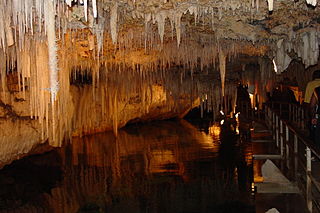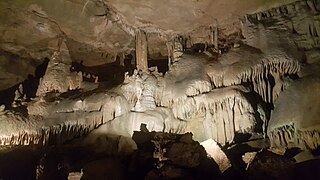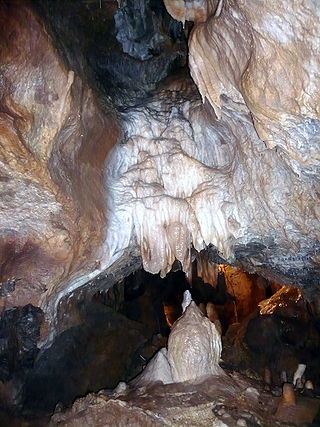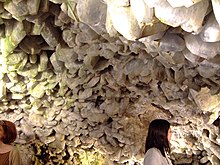
Celestine (the IMA-accepted name) or celestite is a mineral consisting of strontium sulfate (SrSO4). The mineral is named for its occasional delicate blue color. Celestine and the carbonate mineral strontianite are the principal sources of the element strontium, commonly used in fireworks and in various metal alloys.

Strontianite (SrCO3) is an important raw material for the extraction of strontium. It is a rare carbonate mineral and one of only a few strontium minerals. It is a member of the aragonite group.

Mammoth Cave National Park is a national park of the United States in south-central Kentucky. It encompasses portions of Mammoth Cave, the longest known cave system in the world. The park's 52,830 acres (21,380 ha) are located primarily in Edmonson County, with small areas extending eastward into Hart and Barren counties. The Green River runs through the park, with a tributary called the Nolin River feeding into the Green just inside the park.

Put-in-Bay is a resort village located on South Bass Island in Put-in-Bay Township, Ottawa County, Ohio, United States, 85 miles (137 km) west of Cleveland and 35 miles (56 km) east of Toledo. The population was 154 at the 2020 census.
Crystal Cavern(s), also known throughout the years as Alabama Caverns and McClu(n)ney Cave, is a small cavern containing crystal formations located in Clay, Alabama, USA.

A geode is a geological secondary formation within sedimentary and volcanic rocks. Geodes are hollow, vaguely spherical rocks, in which masses of mineral matter are secluded. The crystals are formed by the filling of vesicles in volcanic and subvolcanic rocks by minerals deposited from hydrothermal fluids; or by the dissolution of syn-genetic concretions and partial filling by the same or other minerals precipitated from water, groundwater, or hydrothermal fluids.

Meramec Caverns is the collective name for a 4.6-mile (7.4 km) cavern system in the Ozarks, near Stanton, Missouri. The caverns were formed from the erosion of large limestone deposits over millions of years. Pre-Columbian Native American artifacts have been found in the caverns. Currently the cavern system is a tourist attraction, with more than fifty billboards along Interstate 44 and is considered one of the primary attractions along former U.S. Highway 66. Meramec Caverns is the most-visited cave in Missouri with some 150,000 visitors annually.

Treak Cliff Cavern is a show cave near Castleton in Derbyshire, England. It is part of the Castleton Site of Special Scientific Interest and one of only two sites where the ornamental mineral Blue John is still excavated. As part of an agreement with English Nature, the Blue John that can be seen in the show cave is not mined but it is extracted in small quantities from other areas of the cave and made into saleable items like bowls, jewellery, and ornaments.

South Bass Island is a small island in western Lake Erie, and a part of Ottawa County, Ohio, United States. It is the southernmost of the three Bass Islands and located 3 miles (4.6 km) from the south shore of Lake Erie. It is the third largest island in the Lake Erie Islands, and is part of Put-in-Bay Township. In the bay of South Bass is Gibraltar Island, home to the Ohio State University's Stone Laboratory.

A show cave—also called tourist cave, public cave, and, in the United States, commercial cave—is a cave which has been made accessible to the public for guided visits.

Crystal Cave is a cave in the British overseas territory of Bermuda. It is located in Hamilton Parish, close to Castle Harbour. The cave is approximately 500 m long, and 62 m deep. The lower 19–20 m of the cave are below water level. The cave formed at a time when the sea level was lower; as the sea level rose, many cave formations which formed above water became submerged.

The Wyandotte Caves is a pair of limestone caves located on the Ohio River in Harrison–Crawford State Forest in Crawford County, Indiana, 5 miles (8 km) northeast of Leavenworth and 12 miles (19 km) from Corydon. Wyandotte Caves were designated a National Natural Landmark in 1972, and they are now part of O'Bannon Woods State Park. The cave system is the fifth largest in the state of Indiana, and it is a popular tourist attraction.

The Rainbow River is located in Dunnellon, Florida, United States, in the southwest corner of Marion County, about 20 miles (32 km) southwest of Ocala, 100 miles (160 km) northwest of Orlando and 100 miles (160 km) north of the Tampa Bay area. It is formed by a first-magnitude spring that is ranked fourth in the state for volume of discharge. In addition to the springs located at the headwaters, there are many smaller springs that discharge from numerous caves, rock crevices, and sand boils the entire length of the river.

Raccoon Mountain Caverns is a cave located in Chattanooga, Tennessee in a band of Mississippian Period limestone, part of the Cumberland Plateau.

The Atta Cave or Attendorn Dripstone Cave in Attendorn is one of the largest dripstone caves in Germany.

Peik Chin Myaung (ပိတ်ချင်းမြောင်လိုဏ်ဂူ) is a limestone stalactite cave situated south of Wetwun village, 23 km from Pyin Oo Lwin, Myanmar. The cave is a tourist site on the Lashio road.

Spider Cave, also known as Burnt Bluff Cave or 20DE3, is an archaeological site located on the Garden Peninsula near Fayette, Michigan. It was listed on the National Register of Historic Places in 1971.

The Vacationland region of Ohio—billed as such for being known primarily as a major summertime tourist destination—is the area that is generally considered to be in the north central part of the state, and along the western half of the Lake Erie shoreline around Sandusky Bay, specifically the counties of Erie, Huron, Ottawa, and Sandusky.
İnsuyu Cave is a show cave situated near Burdur in southwestern Turkey. Being over 500 m (1,600 ft) in length, it was discovered in 1952 and opened to public in 1965. A second cave beyond the show cave was later discovered. The lakes inside the both caves are in danger of drying due to excessive drilling of wells in the valley above. However, efforts are underway to reverse the process.

















